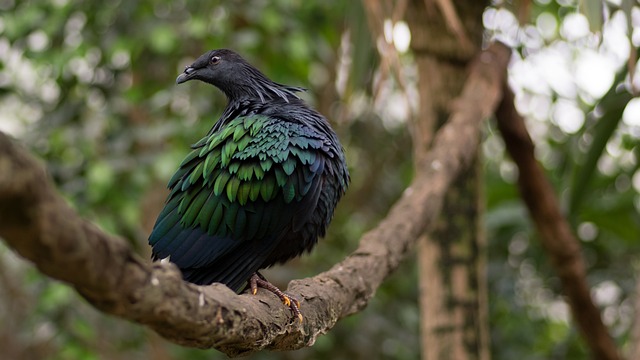
The Nicobar Pigeon, also known as the Nicobar Dove(Caloenas nicobarica) is an enchanting bird native to the tropical islands of Southeast Asia, particularly the Nicobar Islands, which are located near the Indian Ocean. Known for its striking appearance, this bird has captured the interest of ornithologists and bird enthusiasts alike. The Nicobar Pigeon is classified in the avian order Columbiformes, and family Columbidae. The Nicobar Pigeon can live for up to 12 years.
Physical Characteristics
An adult Nicobar Pigeon is 38 centimeters (1 foot 3 inches) in length on average; the average body weight is 519 grams(1.14 pounds); the plumage is distinctive, with iridescent green or green and blue feathers that shimmer in the sunlight. The bill is black and has an enlarged cere, the feet are purplish red. The long “crest-like” feathers that grow out from the neck are known as hackles.
| Genus | Caloenas |
| Species | C. nicobarica |
| Binomial Name | Caloenas nicobarica |
| Length | 32-42 cm(1’1″-1’5″) |
| Weight | 460-600 g(1-1.32 lbs.) |
| IUCN Status | Near threatened |
Habitat And Distribution
The Nicobar Pigeon is primarily found in the Nicobar Islands, however this species can also be seen in Cambodia, India, Indonesia, Malaysia, Myanmar, Palau, Papua New Guinea, Philippines, Solomon Islands, Thailand, Timor-Leste, and Vietnam. Nicobar Pigeons inhabit mangroves, scrub, and forests.
Breeding And Reproductive Behavior
A Nicobar Pigeon’s nest is a platform of twigs. The typical clutch size is one egg. Both parents participate diligently in the incubation process. After hatching, the young are cared for intensively by their parents, who feed them a specialized “crop milk,” a nutrient-rich substance produced in the parents’ crops.
Diet
Nicobar Pigeons eat seeds, Fruits, and insects.
Conservation Status
Currently, the Nicobar Pigeon is classified as Near Threatened by the International Union For Conservation of Nature (IUCN). Habitat destruction, resulting from deforestation and human encroachment, poses significant threats to their populations. Additionally, they are susceptible to hunting.
Conservation efforts are underway to protect the Nicobar Pigeon and its habitat. These initiatives involve creating protected areas, and promoting sustainable land-use practices. The establishment of sanctuaries and the work of various wildlife organizations play a crucial role in ensuring the survival of this extraordinary species.
Conclusion
The Nicobar Pigeon’s unique characteristics make it a subject of fascination for scientists and nature lovers alike. As we work toward conserving this remarkable species, the Nicobar Pigeon serves as a reminder of the rich biodiversity that our planet holds and the importance of protecting it for future generations.
